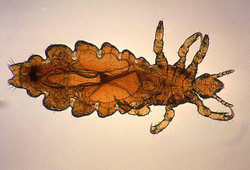"Mommy," [scratch] "my head" [scratch] "itches!"
Sound familiar? It might be lice infestation, the scourge of millions of schoolchildren each year.
Over-the-counter lice shampoos, or pediculicides, include RID and Nix, which contain pyrethrin insecticides. Pyrethrins are mildly toxic irritants of the skin and eyes, and the Environmental Protection Agency considers them possible human carcinogens. They can trigger severe allergic reactions, cause anemia in laboratory animals, and disrupt endocrine function. Pyrethrin-based pediculicides are considered safe for children by mainstream health organizations such as the American Academy of Pediatrics (AAP). But pyrethrins are less and less effective against lice, which are developing genetic resistance to the chemicals.
Pediatricians readily dispense more toxic treatments, such as Kwell, or lindane, which is prescribed up to 1 million times each year. This despite a strengthening, in 2003, of the FDA's warning about the chemical, urging extreme caution for its use in people weighing less than 110 pounds--in other words, most school-aged children. Lindane, a nervous-system toxin, can cause severe seizures in children who have had it applied to their heads. The organochlorine insecticide is also a suspected carcinogen and endocrine disruptor that, once in the environment, does not readily break down. Lindane is banned in dozens of countries, severely restricted in others, and has been banned for lice treatment in California since 2002.
Another prescription-only treatment, Ovide, aims to replace findane with the nerve poison malathion, the most widely used insecticide in the US. In laboratory animals, malathion causes genetic mutations and breast cancer and damages sperm. Less acutely toxic than lindane, malathion is nevertheless quickly absorbed by the skin. This absorption is particularly troubling considering that the instructions accompanying Ovide recommend waiting 8 to 12 hours before washing it off children's heads.
The simplest nonchemical lice cure is mechanical: Manually remove lice by combing the hair of the infested child with a fine-toothed comb. Opinions vary on the best combing strategy. Some suggest combing dry hair with special combs such as the LiceMeister, which is sold by the National Pediculosis Association. Others support wet-combing with a fine-toothed comb, as lice can't move well when wet. Any fine-toothed combing project will be labor-intensive, and the child needs to sit still for long periods. Some lice combs eliminate not just lice but also their eggs, or nits, which attach to hair with a cement-like secretion. Experts differ on whether nit removal is essential in stopping infestation. Some schools require children to be nit-free for attendance, but the AAP and the National Association of School Nurses discourage no-nit policies, partly because the presence of nits only sometimes leads to live lice.
Common household products used against lice include mayonnaise, olive oil, and petroleum jelly. Enzymatic shampoos that claim to dissolve the glue that attaches nits to hair are also available. None of these remedies is approved by the FDA to treat lice, and opinions vary as to their effectiveness. The essential oils that are common ingredients in natural shampoos can be irritants when applied directly to the skin.
Lice live near the scalp and generally require close contact for transmission. They do not survive more than a few hours away from the scalp. To clean the house when someone has lice, gather those household items in direct contact with the head of the person with lice, such as bedding and towels, and either wash them in hot water or dry on high heat for 30 minutes. Vacuuming is also effective. Check other family members for lice. Never spray or fog a house with insecticides to combat lice. With all the scratching, parents sometimes lose sight of what is under that hair: a child's brain, an organ especially vulnerable to the effects of toxic chemicals.
MOLLY RAUCH is science editor of The Green Guide (www.thegreenguide.com)
COPYRIGHT 2005 Mothering Magazine
COPYRIGHT 2005 Gale Group



